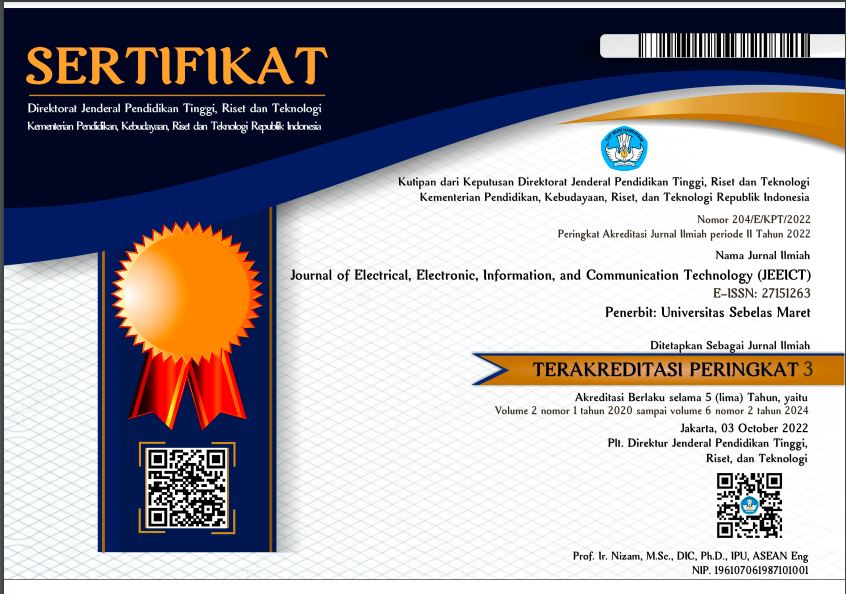Improved Indoor Localization Mechanism for Automated Guided Robots Using Bluetooth Beacons
Abstract
Robot localization is essential for successful navigation, particularly in indoor environments where Global Positioning System (GPS) devices are ineffective. Bluetooth Low Energy (BLE) beacons provide a promising solution by transmitting 2.4GHz signals that can be interpreted by nearby robots. The trilateration method, utilizing Received Signal Strength Indicator (RSSI) values from BLE beacons at predefined locations, enables position estimation. However, RSSI values are highly susceptible to fluctuations and environmental interference, leading to significant errors. This research addresses these challenges by developing a low-cost beacon device using an ESP32 microcontroller and implementing a Kalman filter to minimize RSSI fluctuations. A curve fitting method is applied to convert filtered RSSI data into distance estimates, offering improved accuracy compared to the path loss model. The trilateration approach determines the robot’s position based on three dominant BLE beacons, selected for their signal strength. Results demonstrate that the proposed localization system is effective, with the integration of the Kalman filter and beacon selection mechanism significantly enhancing positional accuracy. This study contributes to the advancement of indoor localization by providing a robust and cost-efficient system suitable for autonomous mobile robot navigation.
Full Text:
PDFReferences
M. T. Ballestar, Á. Díaz-Chao, J. Sainz, and J. Torrent-Sellens, “Knowledge, robots and productivity in SMEs: Explaining the second digital wave,” J. Bus. Res., vol. 108, pp. 119–131, 2020.
F. Rubio, F. Valero, and C. Llopis-Albert, “A review of mobile robots: Concepts, methods, theoretical framework, and applications,” Int. J. Adv. Robot. Syst., vol. 16, no. 2, p. 1729881419839596, 2019.
N. T. T. Van, N. M. Tien, N. C. Luong, and H. T. K. Duyen, “Energy Consumption Minimization for Autonomous Mobile Robot: A Convex Approximation Approach,” J. Robot. Control, vol. 4, no. 3, pp. 403–412, 2023.
F. A. X. Da Mota, M. X. Rocha, J. J. P. C. Rodrigues, V. H. C. De Albuquerque, and A. R. De Alexandria, “Localization and navigation for autonomous mobile robots using petri nets in indoor environments,” IEEE access, vol. 6, pp. 31665–31676, 2018.
R. Haq, “Kendali posisi mobile robot menggunakan sistem proportional integral derivative (pid) dengan metode odometry,” J. Inov. Fis. Indones., vol. 6, no. 3, 2017.
W. Chen and T. Zhang, “An indoor mobile robot navigation technique using odometry and electronic compass,” Int. J. Adv. Robot. Syst., vol. 14, no. 3, p. 1729881417711643, 2017.
A. Handojo, T. Octavia, R. Lim, and J. K. Anggita, “Indoor positioning system using BLE beacon to improve knowledge about museum visitors.” Petra Christian University, 2020.
J. Huang, S. Chai, N. Yang, and L. Liu, “A novel distance estimation algorithm for Bluetooth devices using RSSI,” in 2017 2nd International Conference on Control, Automation and Artificial Intelligence (CAAI 2017), 2017, pp. 379–381.
A. L. Imoize and A. I. Oseni, “Investigation and pathloss modeling of fourth generation long term evolution network along major highways in Lagos Nigeria,” Ife J. Sci., vol. 21, no. 1, pp. 39–60, 2019.
U. M. Qureshi, Z. Umair, Y. Duan, and G. P. Hancke, “Analysis of bluetooth low energy (ble) based indoor localization system with multiple transmission power levels,” in 2018 IEEE 27th International Symposium on Industrial Electronics (ISIE), 2018, pp. 1302–1307.
Z. Kaibi, Z. Yangchuan, and W. Subo, “Research of RSSI indoor ranging algorithm based on Gaussian - Kalman linear filtering,” Proc. 2016 IEEE Adv. Inf. Manag. Commun. Electron. Autom. Control Conf. IMCEC 2016, no. 3, pp. 1628–1632, 2017, doi: 10.1109/IMCEC.2016.7867493.
M. H. P. Swari, I. P. S. Handika, and I. K. S. Satwika, “Comparison of simple moving average, single and modified single exponential smoothing,” in 2021 IEEE 7th Information Technology International Seminar (ITIS), 2021, pp. 1–5.
I. B. Setyawan, A. K. Huda, F. H. Nashrullah, I. D. Kurniawan, S. I. Frans, and J. Hendry, “Noise Removal in The IMU Sensor Using Exponential Moving Average with Parameter Selection in Remotely Operated Vehicle (ROV),” in 2022 8th International Conference on Science and Technology (ICST), 2022, vol. 1, pp. 1–5.
Y. A. Zakaria, E. K. I. Hamad, A. S. A. Elhamid, and K. M. El-Khatib, “Developed channel propagation models and path loss measurements for wireless communication systems using regression analysis techniques,” Bull. Natl. Res. Cent., vol. 45, pp. 1–11, 2021.
D. Puccinelli and M. Haenggi, “Multipath fading in wireless sensor networks: Measurements and interpretation,” in Proceedings of the 2006 international conference on Wireless communications and mobile computing, 2006, pp. 1039–1044.
N. Pakanon, M. Chamchoy, and P. Supanakoon, “Study on accuracy of trilateration method for indoor positioning with BLE beacons,” in 2020 6th international conference on engineering, applied sciences and technology (ICEAST), 2020, pp. 1–4.
J. Luomala and I. Hakala, “Adaptive range-based localization algorithm based on trilateration and reference node selection for outdoor wireless sensor networks,” Comput. Networks, vol. 210, p. 108865, 2022.
L. S. De Oliveira, O. K. Rayel, and P. Leitao, “Low-cost indoor localization system combining multilateration and kalman filter,” in 2021 IEEE 30th International Symposium on Industrial Electronics (ISIE), 2021, pp. 1–6.
Refbacks
- There are currently no refbacks.







